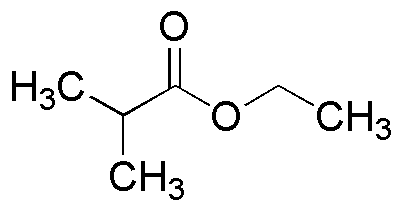Ethyl isobutyrate is widely utilized in research focused on:
- Flavor and Fragrance Industry: This compound is commonly used as a flavoring agent in food products and beverages, providing a fruity aroma reminiscent of apples and pears. Its pleasant scent makes it a popular choice in the formulation of perfumes and cosmetics.
- Solvent Applications: Ethyl isobutyrate serves as an effective solvent in various industrial processes, particularly in paints, coatings, and adhesives. Its ability to dissolve a wide range of substances enhances product performance and application ease.
- Chemical Synthesis: It is used as a building block in organic synthesis, facilitating the production of more complex molecules. This application is particularly valuable in pharmaceuticals and agrochemicals, where precise chemical structures are crucial.
- Research and Development: In laboratories, ethyl isobutyrate is employed in the development of new materials and chemical processes. Its versatility allows researchers to explore innovative applications in polymer science and nanotechnology.
- Perfume Manufacturing: The compound is a key ingredient in the formulation of various fragrances, contributing to the overall scent profile. Its stability and compatibility with other fragrance components make it a preferred choice among perfumers.
General Information
Properties
Safety and Regulations
Applications
Ethyl isobutyrate is widely utilized in research focused on:
- Flavor and Fragrance Industry: This compound is commonly used as a flavoring agent in food products and beverages, providing a fruity aroma reminiscent of apples and pears. Its pleasant scent makes it a popular choice in the formulation of perfumes and cosmetics.
- Solvent Applications: Ethyl isobutyrate serves as an effective solvent in various industrial processes, particularly in paints, coatings, and adhesives. Its ability to dissolve a wide range of substances enhances product performance and application ease.
- Chemical Synthesis: It is used as a building block in organic synthesis, facilitating the production of more complex molecules. This application is particularly valuable in pharmaceuticals and agrochemicals, where precise chemical structures are crucial.
- Research and Development: In laboratories, ethyl isobutyrate is employed in the development of new materials and chemical processes. Its versatility allows researchers to explore innovative applications in polymer science and nanotechnology.
- Perfume Manufacturing: The compound is a key ingredient in the formulation of various fragrances, contributing to the overall scent profile. Its stability and compatibility with other fragrance components make it a preferred choice among perfumers.
Documents
Safety Data Sheets (SDS)
The SDS provides comprehensive safety information on handling, storage, and disposal of the product.
Product Specification (PS)
The PS provides a comprehensive breakdown of the product’s properties, including chemical composition, physical state, purity, and storage requirements. It also details acceptable quality ranges and the product's intended applications.
Certificates of Analysis (COA)
Search for Certificates of Analysis (COA) by entering the products Lot Number. Lot and Batch Numbers can be found on a product’s label following the words ‘Lot’ or ‘Batch’.
*Catalog Number
*Lot Number
Certificates Of Origin (COO)
This COO confirms the country where the product was manufactured, and also details the materials and components used in it and whether it is derived from natural, synthetic, or other specific sources. This certificate may be required for customs, trade, and regulatory compliance.
*Catalog Number
*Lot Number
Safety Data Sheets (SDS)
The SDS provides comprehensive safety information on handling, storage, and disposal of the product.
DownloadProduct Specification (PS)
The PS provides a comprehensive breakdown of the product’s properties, including chemical composition, physical state, purity, and storage requirements. It also details acceptable quality ranges and the product's intended applications.
DownloadCertificates of Analysis (COA)
Search for Certificates of Analysis (COA) by entering the products Lot Number. Lot and Batch Numbers can be found on a product’s label following the words ‘Lot’ or ‘Batch’.
*Catalog Number
*Lot Number
Certificates Of Origin (COO)
This COO confirms the country where the product was manufactured, and also details the materials and components used in it and whether it is derived from natural, synthetic, or other specific sources. This certificate may be required for customs, trade, and regulatory compliance.


